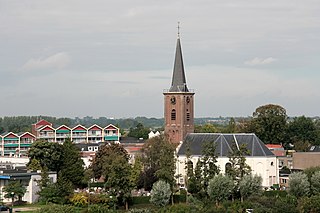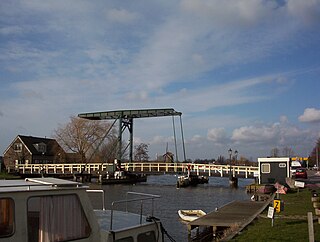
Amsterdam is the capital and most populated city of the Netherlands. It has a population of 921,402 within the city proper, 1,457,018 in the urban area and 2,480,394 in the metropolitan area. Located in the Dutch province of North Holland, Amsterdam is colloquially referred to as the "Venice of the North", for its large number of canals, now a UNESCO World Heritage Site.

Tynaarlo is a village and municipality in the Northeastern Netherlands. Although it is located in the province of Drenthe, many of its communities serve as suburbs of the neighbouring city of Groningen, capital of the eponymous province. In 2019, the municipality of Tynaarlo had a population of 33,698.

Almere is a planned city and municipality in the province of Flevoland, Netherlands across the IJmeer from Amsterdam.

Houten is a municipality in the Netherlands, in the province of Utrecht.

Diemen is a town and municipality with a population of 31,334 in the province of North Holland, Netherlands. It is located approximately 6 km southeast of Amsterdam's city centre, within the Amsterdam metropolitan area.

Weesp is a city, an urban area in the municipality of Amsterdam in the province of North Holland, Netherlands. It had a population of 20,445 in 2021. It lies on the river Vecht and next to the Amsterdam–Rhine Canal in an area called the Vechtstreek. The former municipality of Weesp merged with Amsterdam on 24 March 2022.

Zoetermeer is a city in the Western Netherlands, in the province of South Holland. The municipality covers an area of 37.05 km2 (14.31 sq mi) of which 2.60 km2 (1.00 sq mi) is water. A small village until the late 1960s, it had 6,392 inhabitants in 1950. By 2023 this had grown to 126.998, making it the fourth largest population centre in the province of South Holland, after Rotterdam, The Hague and Leiden. While now a city in its own right, Zoetermeer started out as a suburb of The Hague and is still a part of the Greater The Hague urban area.

Since 1 January 2023, there have been 342 regular municipalities and three special municipalities in the Netherlands. The latter is the status of three of the six island territories that make up the Dutch Caribbean. Municipalities are the second-level administrative division, or public bodies, in the Netherlands and are subdivisions of their respective provinces. Their duties are delegated to them by the central government and they are ruled by a municipal council that is elected every four years. Municipal mergers have reduced the total number of municipalities by two-thirds since the first official boundaries were created in the mid 19th century. Municipalities themselves are informally subdivided into districts and neighbourhoods for administrative and statistical purposes.

Monnickendam is a city in the Dutch province of North Holland. It is a part of the municipality of Waterland, and lies on the coast of the Markermeer, about 8 km (5.0 mi) southeast of Purmerend. It received city rights in 1355 and was damaged by the fires of 1500 and 1513.
The Government of Amsterdam consists of several territorial and functional forms of local and regional government. The principal form of government is the municipality of Amsterdam, Netherlands. The municipality's territory covers the city of Amsterdam as well as a number of small towns. The city of Amsterdam is also part of several functional forms of regional government. These include the Waterschap of Amstel, Gooi en Vecht, which is responsible for water management, and the Stadsregio of Amsterdam, which has responsibilities in the areas of spatial planning and public transport.

Emmen is a municipality and town of the province of Drenthe in the northeastern Netherlands.

Wieringerwerf is a town in the Dutch province of North Holland. It is a part of the municipality of Hollands Kroon, and lies about 21 kilometres (13 mi) southeast of Den Helder. It is situated in a polder. The elevation of the village is 4 metres (13 ft) below sea level. Dikes and pumping engines keep the land dry.

Amsterdam-Zuidoost is a borough (stadsdeel) of Amsterdam, Netherlands. It consists of four residential neighborhoods—Bijlmermeer, Venserpolder, Gaasperdam and Driemond—as well as the Amstel III/Bullewijk Business Park and the Amsterdam Arena entertainment and shopping district.

Mijdrecht is a town in the Netherlands with about 16,000 residents. It is located in the municipality of De Ronde Venen, about 7 kilometres (4.3 mi) west of the main A2 motorway, between Utrecht and Amsterdam.

Polsbroek is a village in the Dutch province of Utrecht. It is a part of the municipality of Lopik, and lies about 10 km southeast of Gouda.

Vijfhuizen is a village in the Dutch province of North Holland. It is a part of the municipality of Haarlemmermeer, and lies about 4 km southeast of Haarlem. In January 2011, the town of Vijfhuizen had 4387 inhabitants. The built-up area of the town was 0.48 km2, and contained 728 residences. The wider statistical area of Vijfhuizen has a population of around 2800.

Zwaanshoek is a village in the Dutch province of North Holland. It is a part of the municipality of Haarlemmermeer, and lies about 4 km west of Hoofddorp. On the other side of the canal lies the village of Bennebroek, which is connected to Zwaanshoek by a bridge.

Jo Coenen is a Dutch architect and urban planner. He studied architecture at the Eindhoven University of Technology, and later held professorships at TU Karlsruhe, Eindhoven University of Technology and Delft University of Technology.

Amsterdam-Zuid is a borough (stadsdeel) of Amsterdam, Netherlands. The borough was formed in 2010 as a merger of the former boroughs Oud-Zuid and Zuideramstel. The borough has almost 138,000 inhabitants (2013). With 8,500 homes per square kilometer, it is one of the most densely populated boroughs of Amsterdam. It has the highest income per household of all boroughs in Amsterdam.

The boroughs of Amsterdam are the seven principal subdivisions of the municipality of Amsterdam, Netherlands. Each borough is governed by a directly elected district committee (bestuurscommissie). The first Amsterdam boroughs were created in 1981, with other boroughs created in later years. The last area to be granted the status of borough was Amsterdam-Centrum (2002). The existing system of seven boroughs, covering most parts of Amsterdam, is the result of a major borough reform in 2010. The current boroughs have populations of around 80,000 to 150,000, which is the equivalent to an average-sized municipality in the Netherlands. Since 2022, there is also the urban area Weesp.






















